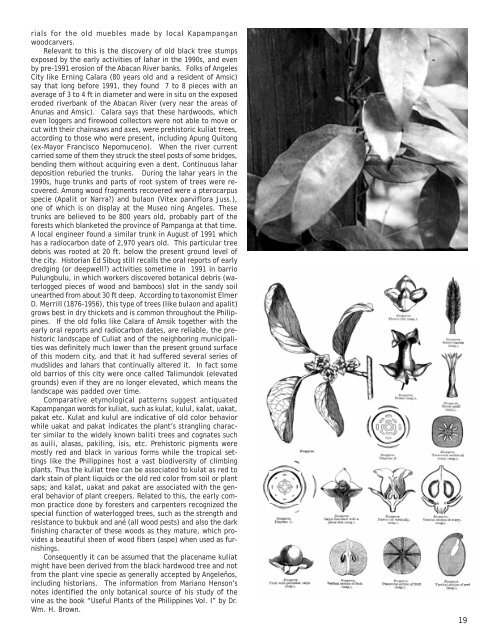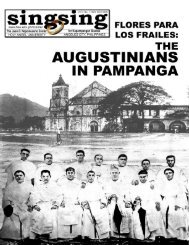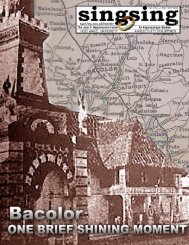Download PDF - Holy Angel University
Download PDF - Holy Angel University
Download PDF - Holy Angel University
You also want an ePaper? Increase the reach of your titles
YUMPU automatically turns print PDFs into web optimized ePapers that Google loves.
ials for the old muebles made by local Kapampangan<br />
woodcarvers.<br />
Relevant to this is the discovery of old black tree stumps<br />
exposed by the early activities of lahar in the 1990s, and even<br />
by pre-1991 erosion of the Abacan River banks. Folks of <strong>Angel</strong>es<br />
City like Erning Calara (80 years old and a resident of Amsic)<br />
say that long before 1991, they found 7 to 8 pieces with an<br />
average of 3 to 4 ft in diameter and were in situ on the exposed<br />
eroded riverbank of the Abacan River (very near the areas of<br />
Anunas and Amsic). Calara says that these hardwoods, which<br />
even loggers and firewood collectors were not able to move or<br />
cut with their chainsaws and axes, were prehistoric kuliat trees,<br />
according to those who were present, including Apung Quitong<br />
(ex-Mayor Francisco Nepomuceno). When the river current<br />
carried some of them they struck the steel posts of some bridges,<br />
bending them without acquiring even a dent. Continuous lahar<br />
deposition reburied the trunks. During the lahar years in the<br />
1990s, huge trunks and parts of root system of trees were recovered.<br />
Among wood fragments recovered were a pterocarpus<br />
specie (Apalit or Narra?) and bulaon (Vitex parviflora Juss.),<br />
one of which is on display at the Museo ning <strong>Angel</strong>es. These<br />
trunks are believed to be 800 years old, probably part of the<br />
forests which blanketed the province of Pampanga at that time.<br />
A local engineer found a similar trunk in August of 1991 which<br />
has a radiocarbon date of 2,970 years old. This particular tree<br />
debris was rooted at 20 ft. below the present ground level of<br />
the city. Historian Ed Sibug still recalls the oral reports of early<br />
dredging (or deepwell?) activities sometime in 1991 in barrio<br />
Pulungbulu, in which workers discovered botanical debris (waterlogged<br />
pieces of wood and bamboos) slot in the sandy soil<br />
unearthed from about 30 ft deep. According to taxonomist Elmer<br />
D. Merrill (1876-1956), this type of trees (like bulaon and apalit)<br />
grows best in dry thickets and is common throughout the Philippines.<br />
If the old folks like Calara of Amsik together with the<br />
early oral reports and radiocarbon dates, are reliable, the prehistoric<br />
landscape of Culiat and of the neighboring municipalities<br />
was definitely much lower than the present ground surface<br />
of this modern city, and that it had suffered several series of<br />
mudslides and lahars that continually altered it. In fact some<br />
old barrios of this city were once called Talimundok (elevated<br />
grounds) even if they are no longer elevated, which means the<br />
landscape was padded over time.<br />
Comparative etymological patterns suggest antiquated<br />
Kapampangan words for kuliat, such as kulat, kulul, kalat, uakat,<br />
pakat etc. Kulat and kulul are indicative of old color behavior<br />
while uakat and pakat indicates the plant’s strangling character<br />
similar to the widely known baliti trees and cognates such<br />
as auili, alasas, pakiling, isis, etc. Prehistoric pigments were<br />
mostly red and black in various forms while the tropical settings<br />
like the Philippines host a vast biodiversity of climbing<br />
plants. Thus the kuliat tree can be associated to kulat as red to<br />
dark stain of plant liquids or the old red color from soil or plant<br />
saps; and kalat, uakat and pakat are associated with the general<br />
behavior of plant creepers. Related to this, the early common<br />
practice done by foresters and carpenters recognized the<br />
special function of waterlogged trees, such as the strength and<br />
resistance to bukbuk and ané (all wood pests) and also the dark<br />
finishing character of these woods as they mature, which provides<br />
a beautiful sheen of wood fibers (aspe) when used as furnishings.<br />
Consequently it can be assumed that the placename kuliat<br />
might have been derived from the black hardwood tree and not<br />
from the plant vine specie as generally accepted by <strong>Angel</strong>eños,<br />
including historians. The information from Mariano Henson’s<br />
notes identified the only botanical source of his study of the<br />
vine as the book “Useful Plants of the Philippines Vol. I” by Dr.<br />
Wm. H. Brown.<br />
19








